Welcome to BrightLocal’s 2018 Voice Search for Local Business Study
We’re living in a voice-activated world, with Google Home, Amazon’s Alexa, Apple’s Siri, and Microsoft’s Cortana making it into more consumers’ homes—and pockets. But while the onslaught of voice search is well-established, there has been comparatively little exploration of its impact on local businesses.
To rectify this, we set out to explore how consumers use voice search to discover, contact, and find local businesses. In April 2018, we asked a panel of 1,012 US-based consumers to share their experiences and opinions when using voice assistants and smart speakers. See more on the methodology here.
Questions
- Have you used voice search to find information for a local business in the last 12 months?
- How frequently do you use voice search to find information on local businesses?
- Which of the following business types would you consider searching for using voice search?
- In which circumstances would you use voice search?
- In which circumstances would you like to use voice search for local businesses?
- What is the typical next step you take after making a voice search for a local business?
1. Have you used voice search to find information for a local business in the last 12 months?
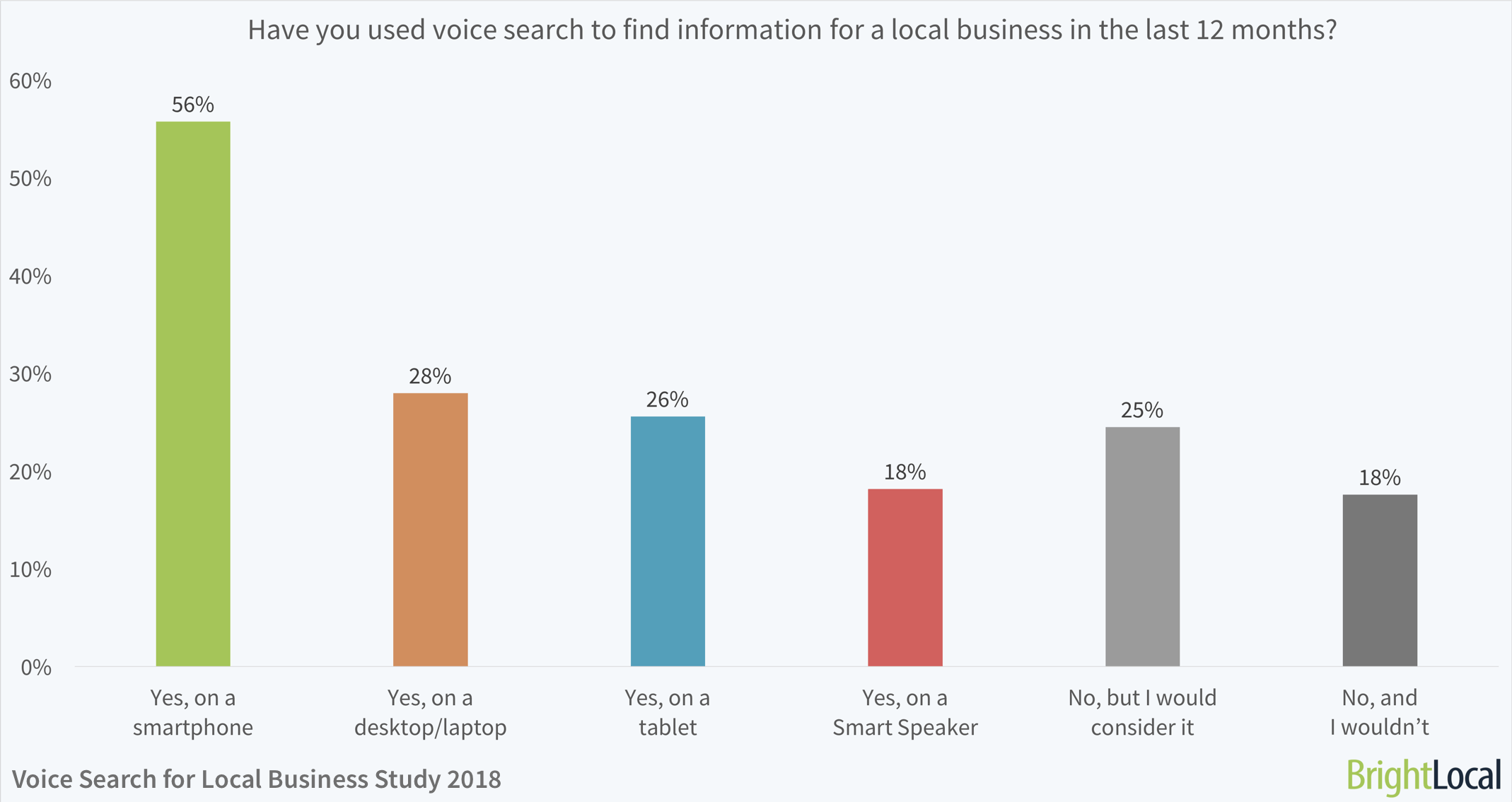 Age group split: Have you used voice search to find information for a local business in the last 12 months?
Age group split: Have you used voice search to find information for a local business in the last 12 months?
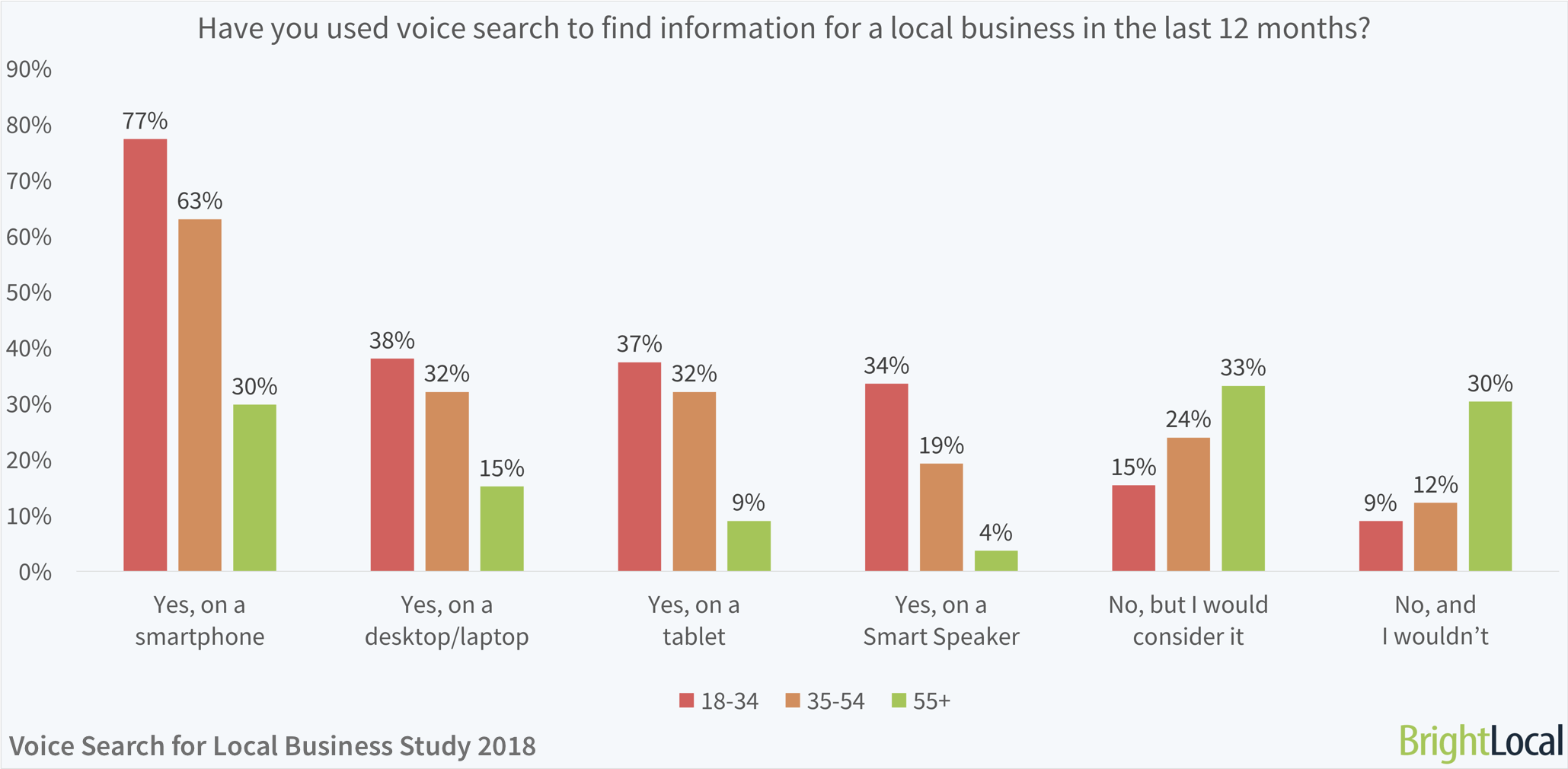 Gender split: Have you used voice search to find information for a local business in the last 12 months?
Gender split: Have you used voice search to find information for a local business in the last 12 months?
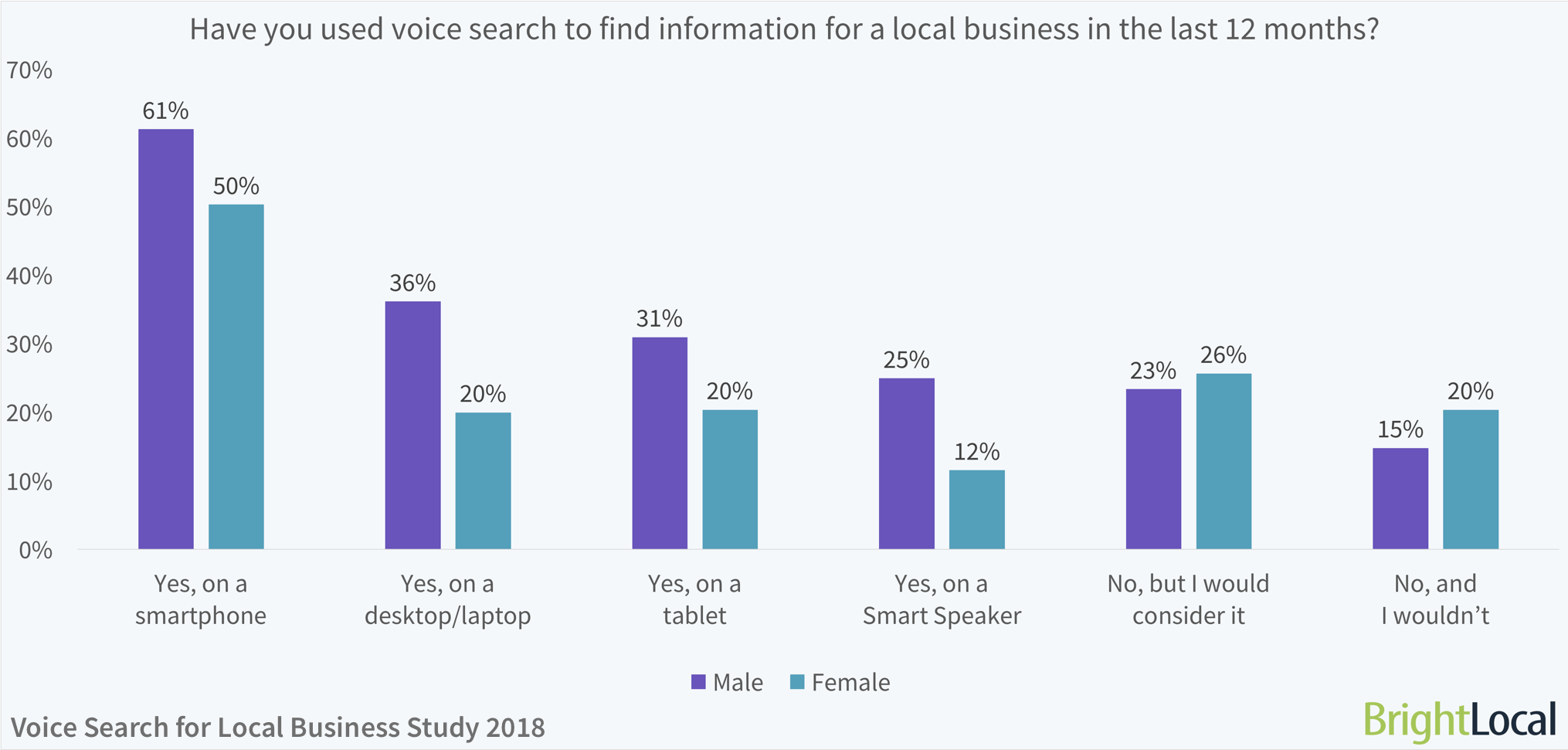 Respondents were able to select multiple responses.
Respondents were able to select multiple responses.
Key Findings
- 58% of consumers used voice search to find information on a local business in the last 12 months
- Just 18% of people say they wouldn’t use voice search for local business information
- There’s still room for voice search to grow: 25% of consumers haven’t yet tried local voice search, but would consider it
- Smartphones are the most popular tool for voice searches for local businesses—with Smart Speakers being the least commonly used
- Those aged 55+ are least likely to have used voice search for local businesses—but 33% would consider doing so
- Men are more likely to have used local voice search than women
Most Popular Voice Search Tools for Local Businesses
- Smartphone (56% have tried)
- Desktop/Laptop (28%)
- Tablet (26%)
- Smart Speaker (18%)
Insights
While voice search has seen huge growth over the last few years, its prevalence for local businesses cannot be overstated. 58% of consumers used voice to find information on a local business in the last 12 months—with different consumers opting to use the four main voice search devices.
But local businesses are likely to benefit from a continued growth in voice searches. 25% of consumers told us they hadn’t yet made voice searches for local businesses—but would consider it in the future.
With a potential 82% of consumers willing to use voice search locally, businesses need to make sure they are both easily discoverable in voice search results, and supplying the information consumers really need.
With smart speakers dominating headlines, we were surprised that the proportion of consumers who have used smart speakers for local business searches was so low (18%). However, this is actually in line with the one in six Americans who own a smart speaker — suggesting that the chatter around Alexa, Google Home and the like is louder than its actual impact.
We’d expect to see this number grow in line with the popularity of smart speakers — especially if these begin to gain favor with older consumers who are so far less experienced using these.
Perhaps unsurprisingly, those aged 18-34 were most likely to have performed a local search (76%). For those aged 35-54, this was 64%. Just 37% of consumers older than 55 have tried using voice search for local businesses.
The real story for voice search right now is more about portability. Far more consumers are relying on their smartphones—with 61% of men and 50% of women using their phones for local voice search in the last year.
2. How frequently do you use voice search to find information on local businesses?
The below charts are based on the experiences of consumers who use voice search at least once per year.
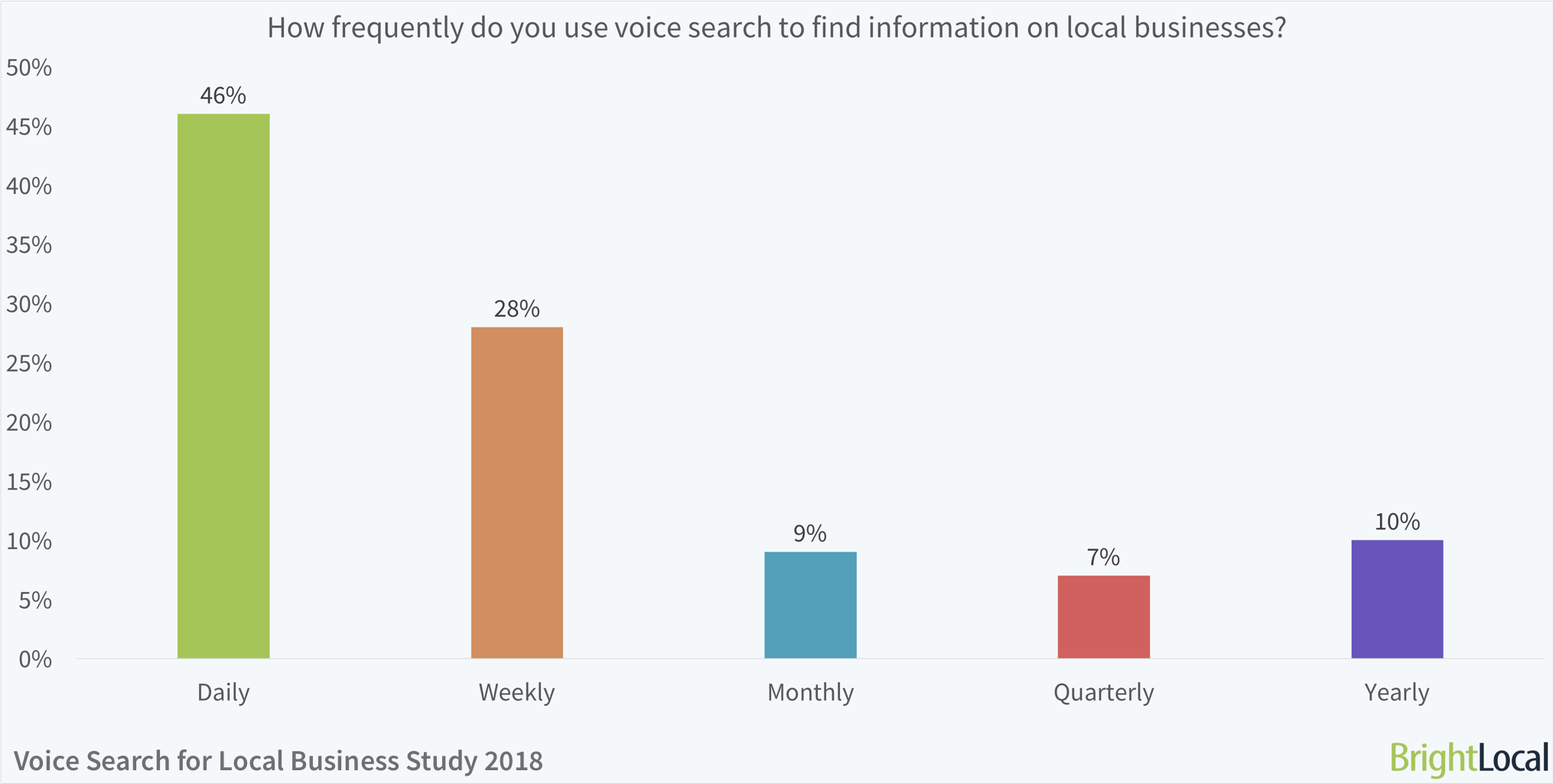
Device split: How frequently do you use voice search to find information on local businesses?
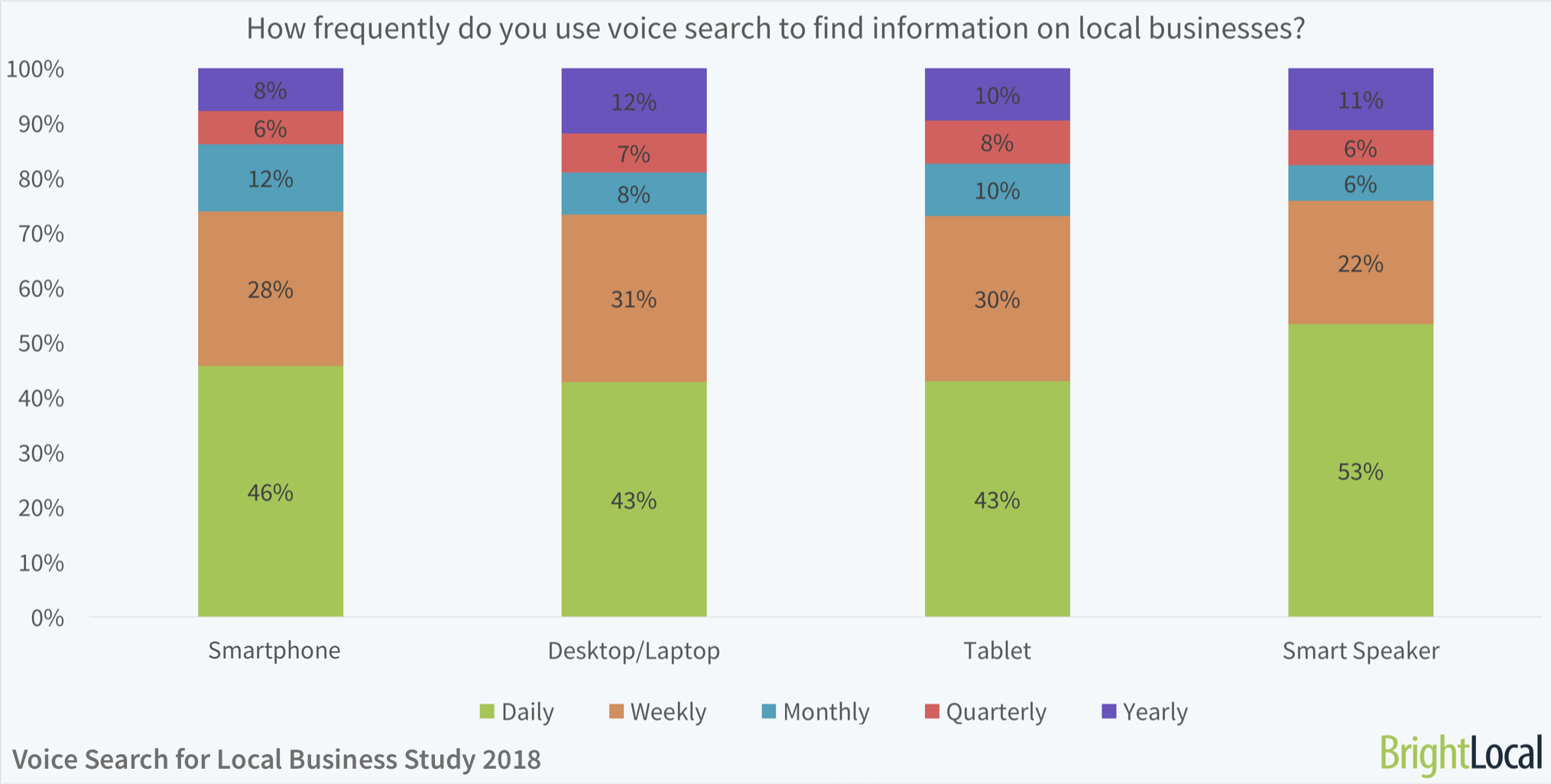
Age split: Consumers who use local voice search at least once per month
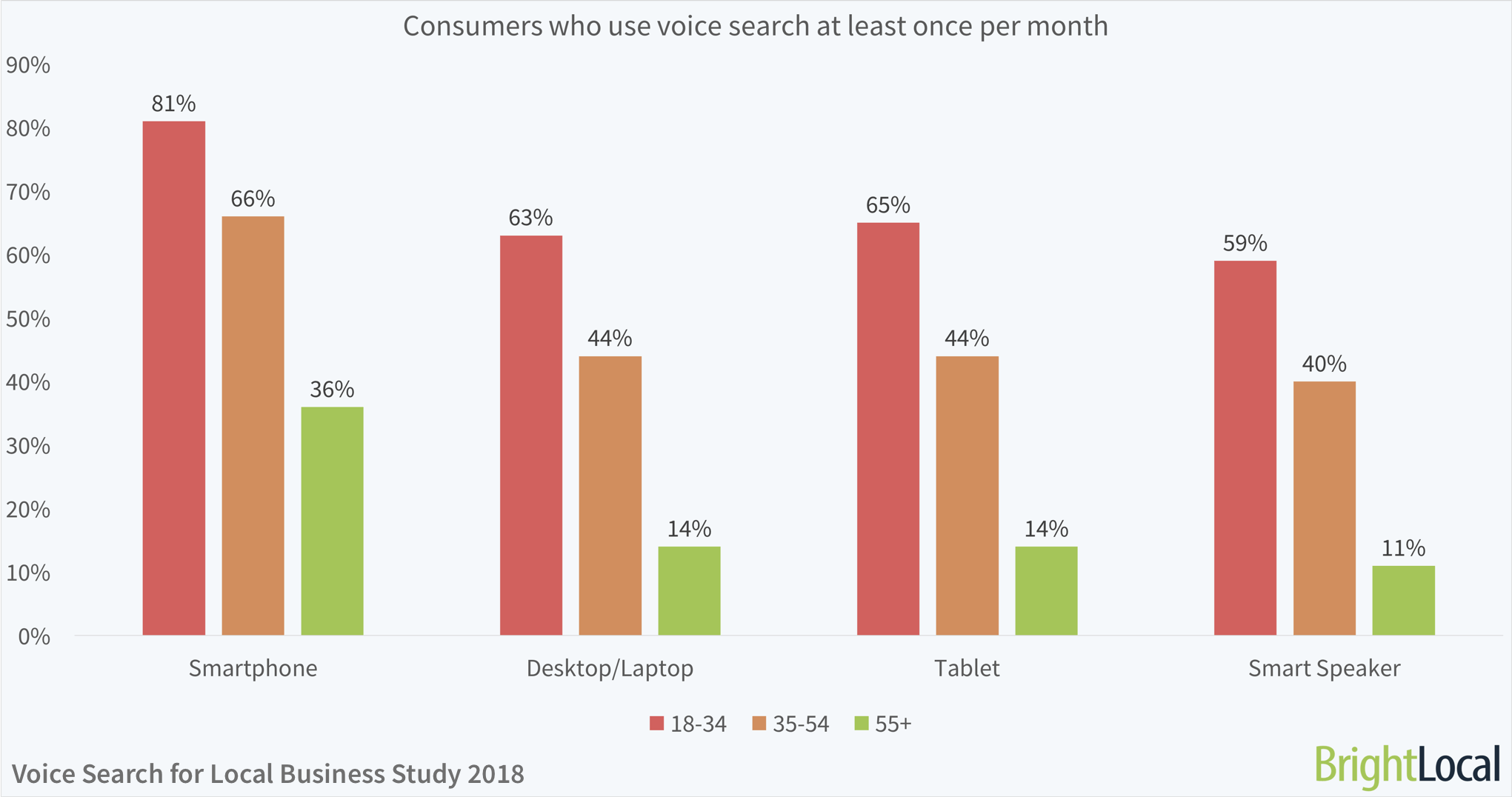
Gender split: Consumers who use local voice search at least once per month
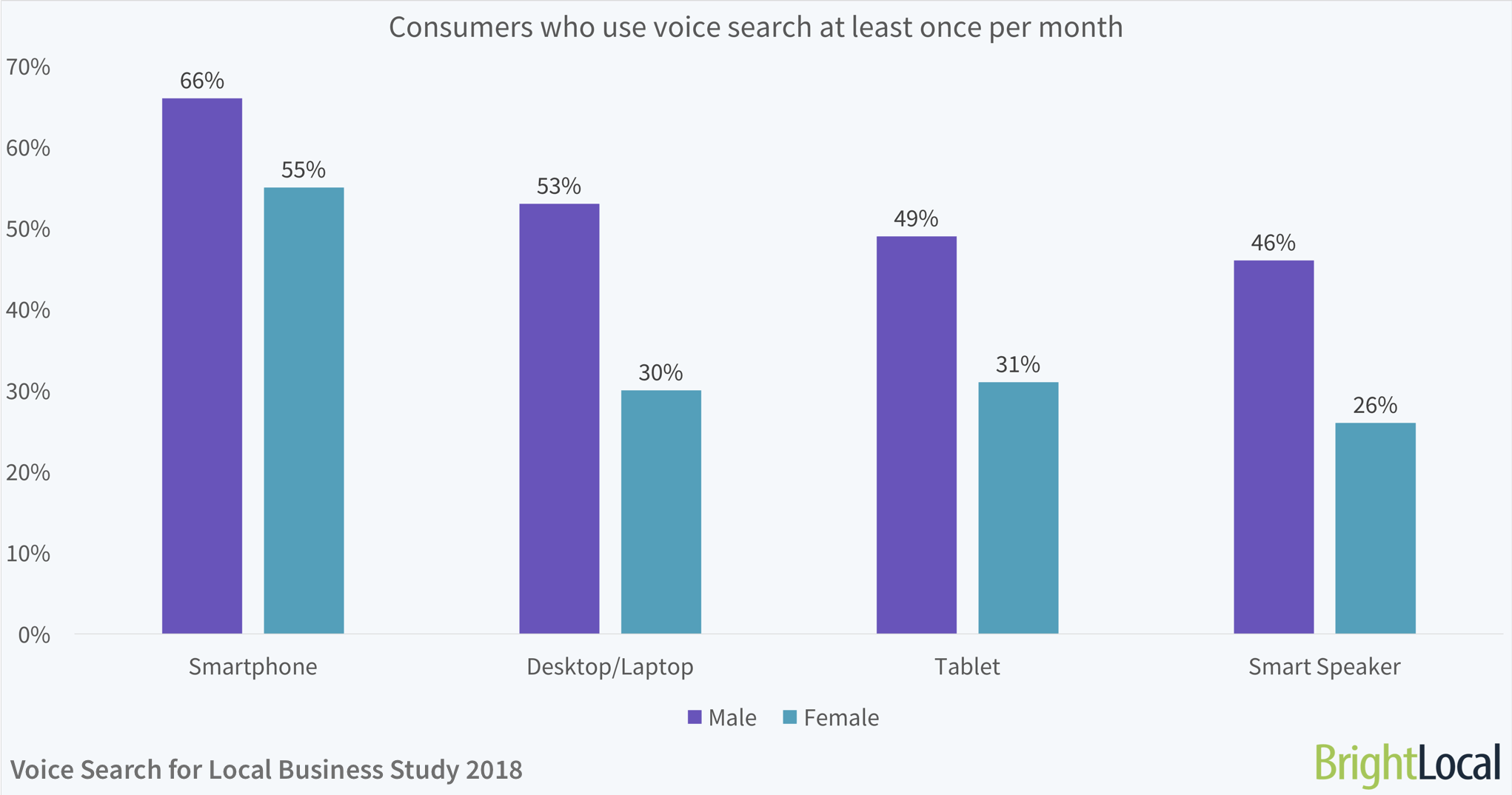
Key Findings
- 46% of voice search users search for a local business daily, with a further 28% searching once a week
- 74% of smartphone voice search users search for local businesses at least once per week
- 76% use smart speakers for local search at least weekly—with 53% searching every day
Insights
Among those who already use voice search locally, there is a high frequency of use.
46% of users look for local business information at least once a day. Just 17% of voice search users look for local information less frequently than monthly.
As seen above, smartphones are the most used voice search tool — but among users, surprisingly not the most popular. We’d expect the ability to make searches on the move would only add to the frequency of voice searches. Perhaps this could be down to people feeling less inclined to ask a question in public?
Those using smart speakers are the most likely to make local searches daily (53%). Just 18% do this less than once a month. This frequency could be for a multitude of reasons. Are owners excited to test out and play with their new toy? Or, could the privacy of a search at home mean consumers ask more frequent questions?
When looking at those aged 18-34, they clearly favor smartphones above the other types of voice assistant — with 81% using these at least once per month to look for businesses near them. This is followed by tablets (65%), then desktop/laptop (63%).
We can also see that men are more likely than women to use local voice search frequently across the different devices. This is in line with research from Stone Temple Consulting, that found that men were 1.59 times more likely to use voice commands than women.
3. Which business types would you consider using voice search to find?
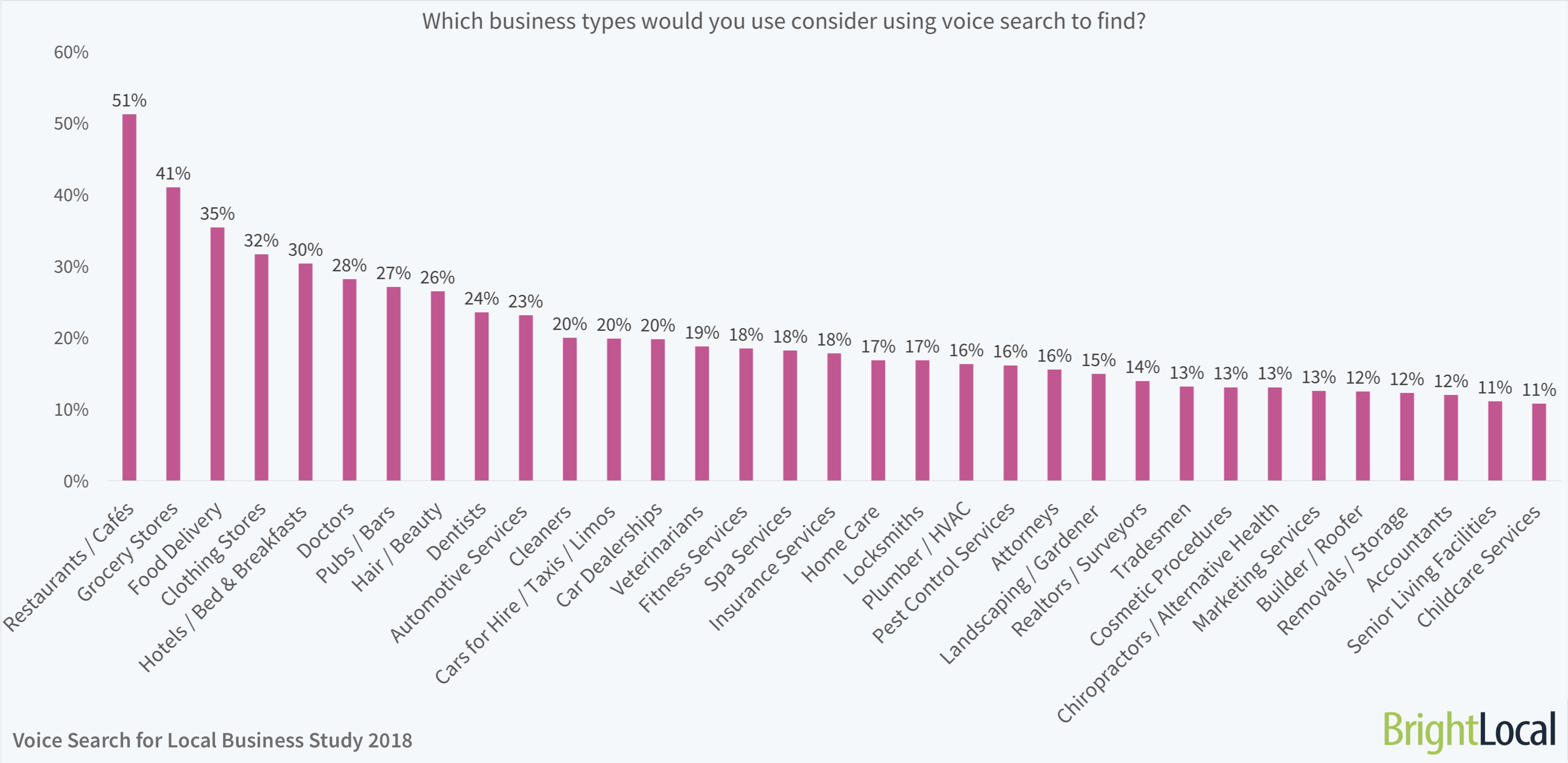
Respondents were able to select multiple responses.
Top Industries For Voice Searches
- Restaurants / Cafés (51% of consumers would use voice search to find)
- Grocery stores (41%)
- Food delivery (35%)
- Clothing stores (32%)
- Hotels / Bed & Breakfasts (30%)
Insights
Every business type that we put to our consumer panel has the potential for local voice searches. There was a sliding scale of importance for these industries—but even those at the lower end, such as accountants, builders, and removals risk missing potential customers if they aren’t showing up.
It makes sense that the industries that are most likely to see a lot of ‘discovery’ voice searches are those that would generally see more frequent searches. After all, a searcher has a more regular need for a grocery store than a new accountant!
Throughout the study, we’ve seen that restaurants have the most to gain from optimizing for voice search. Those that are most visible in voice searches will have the benefit of being ahead of their competitors at this early stage of the voice search revolution.
While you can’t optimize solely for voice search, there are plenty of ways to improve your potential visibility. Voice search results, particularly on Google Home, are often pulled from featured snippets—so focus your content plan around the questions that people near you need answering.
Setting up schema markup correctly will also help maximize your chances of the right data appearing in voice searches—though be careful to keep these up to date, or risk the wrath of a Google manual action.
Being ahead of the pack and focusing on general search visibility will only improve the likelihood of appearing in voice results now and in the future. For more tips on this, see our article How to Optimize for Voice Search.
4. In which circumstances would you use voice search for a local business?
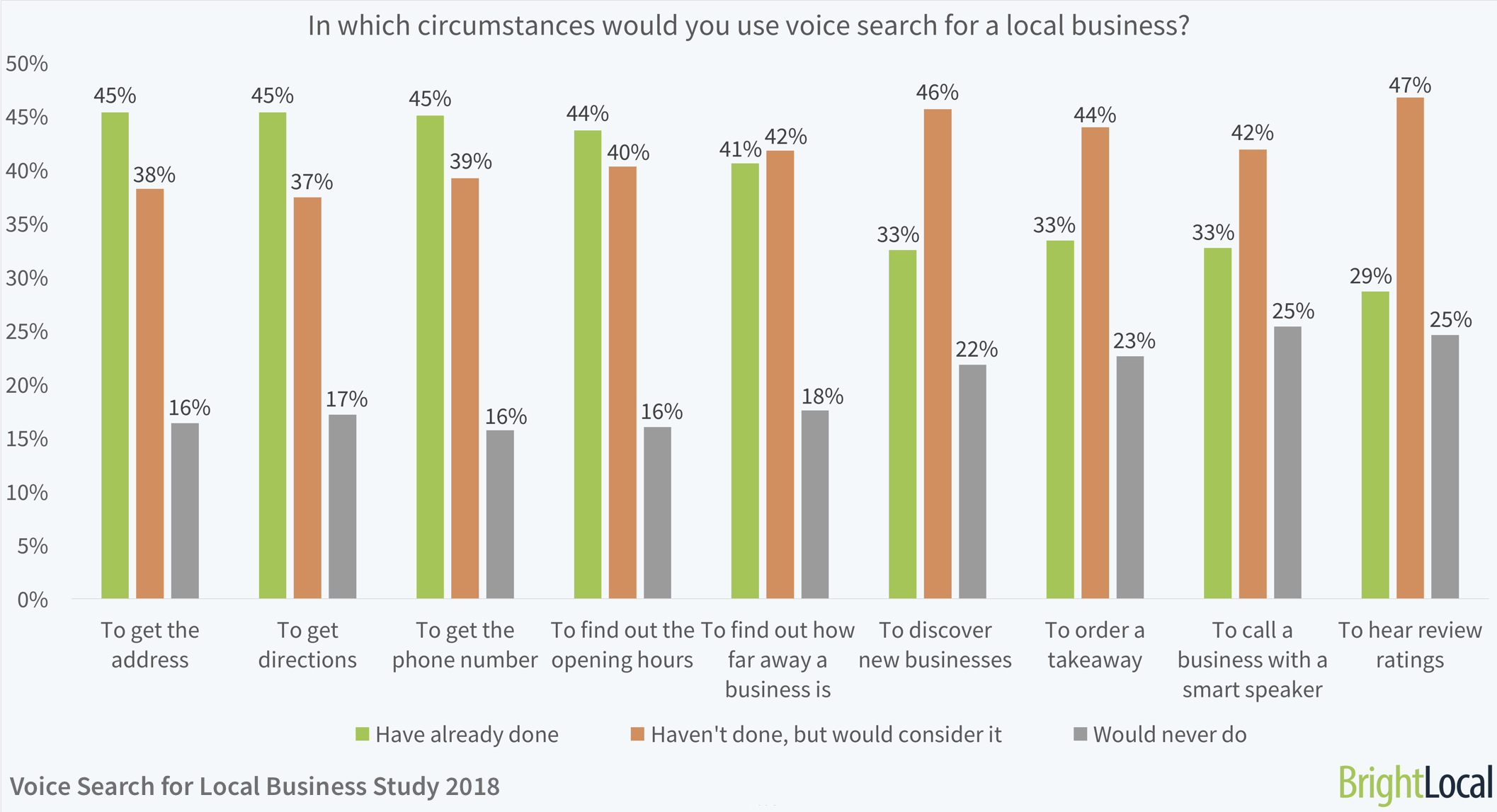
Key Findings
- Consumers use voice search to find local businesses’ phone numbers, addresses, directions and opening hours
- 33% say they’ve ordered a takeaway using voice search
- Consumers are open-minded to trying different voice-assisted functions
Insights
Consumers clearly use local voice searches for many reasons, but our survey finds they’re most likely to have performed searches to find further information on businesses they already know(such as address, directions, and phone number). Searchers are less likely to use the technology for business discovery purposes.
Looking for review ratings isn’t particularly common yet, but it holds a lot of potential with 47% of consumers saying they might in the future. This could be down the varying capabilities of different voice search technologies when it comes to reviews and ratings.
33% of consumers have called a local business using their smart speaker, making it all the more important for details to be correct online. Our recent Local Citations Trust Report found that 36% of consumers called a wrong number for a business because of incorrect information displayed online, so it’s critical for local businesses to check their online business listings are accurate to avoid this.
Behaviors are still forming around voice search, so it’ll be interesting to see if the proportion of consumers using these features grows over the next few years. Will consumers change their mind about what they’d ‘never do’ when functions become more commonplace?
5. In which circumstances would you like to use voice search for local businesses?
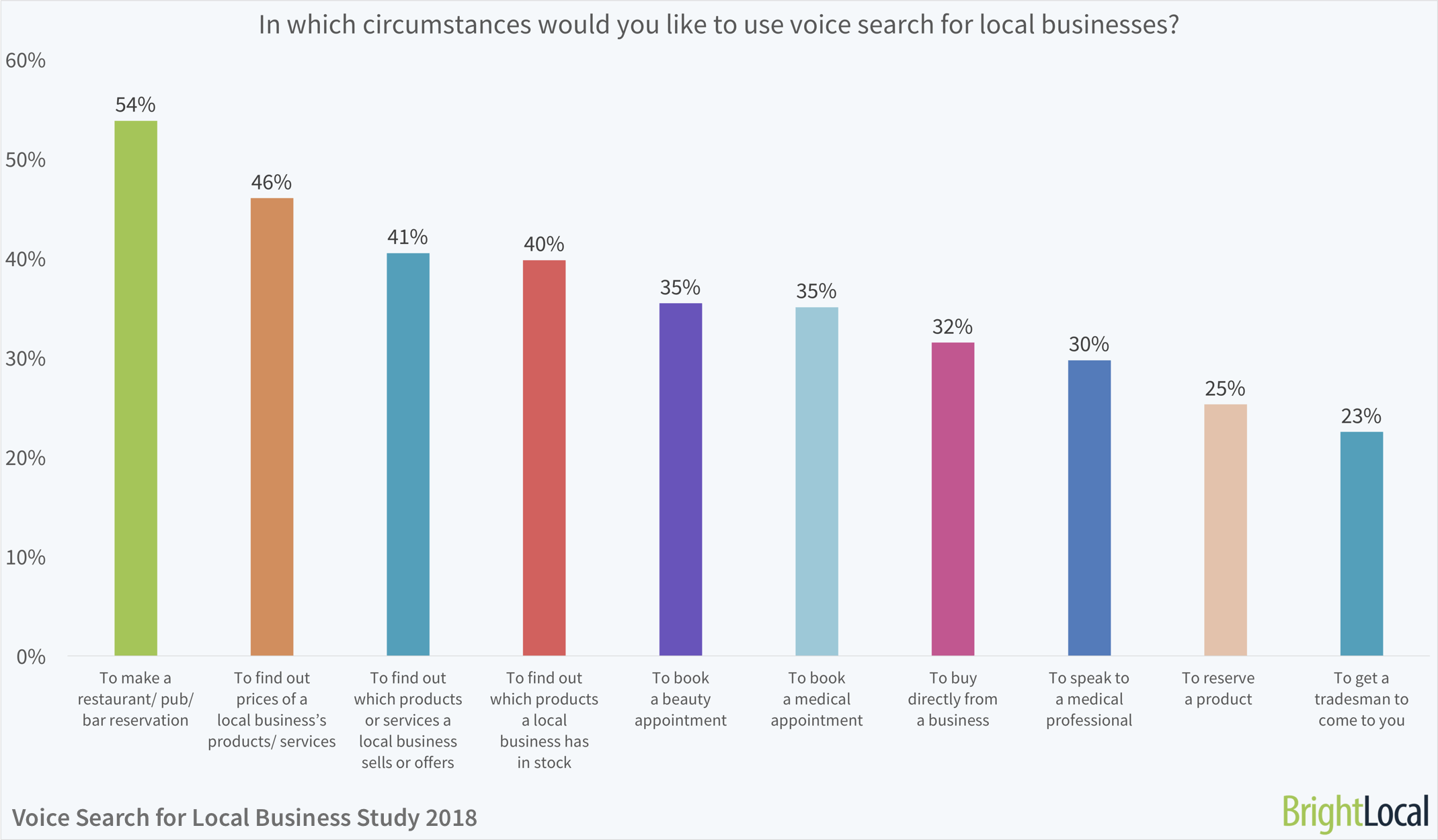
Respondents were able to select multiple responses. At the time of publication, none of the above services were possible using voice search.
Key Findings
- 54% of consumers would like to be able to make a restaurant or bar reservation using voice search
- 46% would like to hear local businesses’ prices in voice search results
- 35% would like to book beauty or medical appointments using voice search
Insights
Smart speakers and voice assistants are adding new features and functionalities every day, but we wanted to know what consumers want to be able to see next.
We found that consumers would value more functionality with the low-risk things that they do regularly, such as visiting restaurants and bars. This is far more in-demand than higher-cost, low-frequency needs like requesting a callout from a tradesman. Perhaps this could be attributed to the higher level of trust required when picking services like tradesmen. The recommendation of Siri or Alexa alone may not be enough to invite a stranger into your home!
Local shoppers seem to want information, but not necessarily action, from their voice searches. Interestingly, finding out the prices, products or services of a local business are popular among consumers. This means it’s critical for search engines to be able to recognize this information. The continued development of structured data should allow local business websites to fully mark up their product and service pages in a way that’s universally recognized by search engines.
Of course, there are an untold number of potential features for local businesses that could come to voice search. The above features are based on a shortlist of potentially helpful features from minds of the BrightLocal team. If there are any more local voice search features you think would be useful for consumers, let us know in the comments.
6. What is the typical next step you take after making a voice search for a local business?
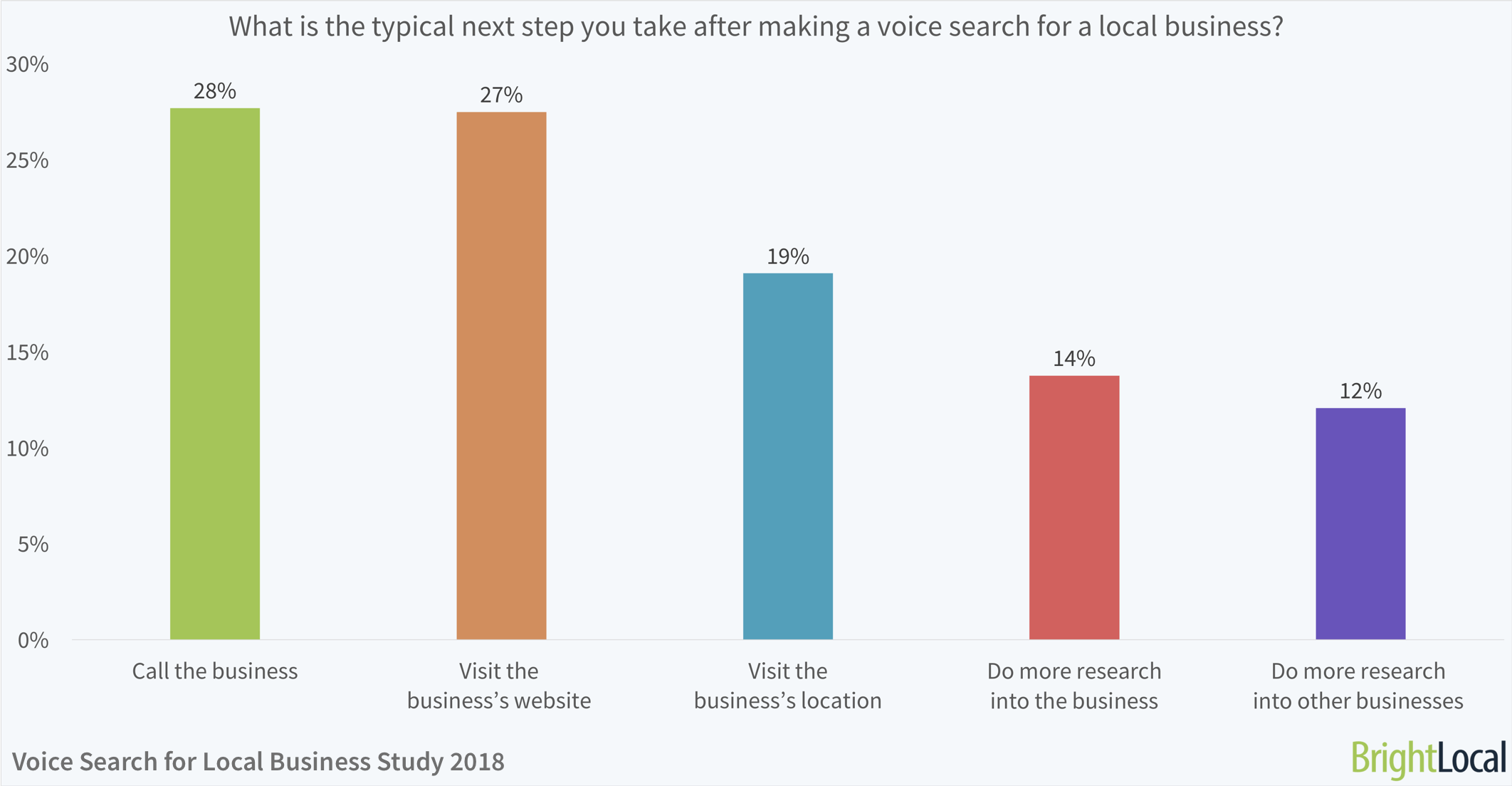
Key Findings
- After making a local voice search, 28% call the business
- 27% visit the website of a local business after making a voice search
- 19% will visit the business after making a voice search
Insights
Whether it’s by visiting the business or contacting them by phone, a combined 47% of consumers get in touch with a business after making a local voice search.
In our latest Local Consumer Review Survey, we found that 27% of consumers contact or visit a business after reading a positive review—far fewer than those using voice search.
Of course, when comparing the two, those looking at reviews are likely to be in a different part of the buyer journey (research or consideration) than those making a voice search. As we’ve seen above, voice searches for local businesses are far more likely to be for people who are already aware of a business and want to find specific information on it.
It’s interesting to see how many consumers go to a business’s website following a local voice search. For consumers wanting to continue their research, most voice assistants give options to send URLs and information straight to a linked smartphone. While questions have been raised about the ongoing necessity of local business websites, it’s evident that websites are still very important in the voice search journey.
For local businesses, there are clear opportunities around voice search. With ComScore predicting that 50% of all searches will be made by voice by 2020, it’s only going to become more important for local businesses to get their voices heard.
Methodology
The Voice Search for Local Business Study is based on a representative sample of 1,012 US-based consumers. It was conducted in April 2018 with an online consumer panel.
When analyzing Q2, we removed respondents who did not have experience using local voice search to better represent the frequency of voice searches among users.
We also looked into how trends differed based on the ages (18-34, 35-54, 55+) or genders of respondents, and included the most interesting findings. If there were any further questions you’d like to see demographic splits for, please get in touch.
If you have any questions or thoughts on the Voice Search for Local Business Study, please contact content@brightlocal.com, or leave a comment below. Publishers are welcome to use charts and data, crediting BrightLocal and linking to this report’s URL.
Thanks for reading the Voice Search for Local Business Study 2018!
What do you think is next for local voice search? Let us know in the comments below.

